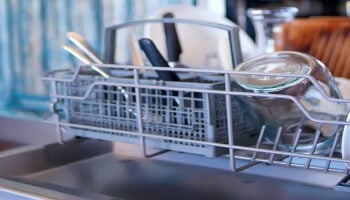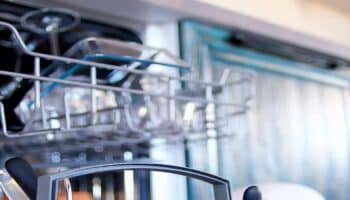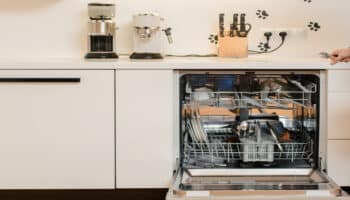We've independently reviewed this article to make sure it's as accurate as we can make it.
To find out more about our article creation and review process, check out our editorial guidelines.
Have you ever wondered how your countertop dishwasher works?
You’ve come to the right place for answers! Although there are some differences between a normal and a tabletop dishwasher, they all generally operate in a similar way.
When you close your countertop dishwasher, the door latch activates the wash cycle. The control board activates the water valve, and the float switch ensures proper water level. Then, the wash motor circulates water through the spray arms, the heating element activates, and the drain cycle begins.
Read on to learn more about how countertop dishwasher work!
Why trust us? This article was written by Craig Anderson and James Blackford.
Craig has helped thousands of other homeowners repair their appliances since 2016. James is one of our resident appliance experts, with over 16 years of experience. He currently works as a Master Technician for SquareTrade, and runs his own appliance repair business.
How Do Countertop Dishwashers Work?
Understanding how your countertop dishwasher works can help you self-diagnose any issues you may encounter.
In this section, I’ll walk you through the main components of a countertop dishwasher in the order they activate, so you can better understand how they work.
#1 Door Latch
When understanding how countertop dishwasher work, it’s important to note that the initial step in the process involves the activation of the door latch.
You see, once you’ve loaded your countertop dishwasher, closed the door, and selected the cycle in the interface, a door latch, also known as a “door lock” or “door switch,” activates.
This component is responsible for keeping the door closed during operation and preventing leaks.
It will also stop the operation if the door is suddenly open during a wash cycle.
#2 Control Board
You can think of the control board as the brain of your countertop dishwasher! It coordinates different functions, such as the duration of each cycle and the cycle selection.
So, once the door is closed, and you press the “Start” button, the control board is responsible for sending 110 volts of electricity to the water valve.
From what I’ve seen, countertop dishwashers don’t have an elaborate control board like larger dishwashers.
#3 Water Valve
Countertop dishwashers work in a similar way to other dishwashers, but they typically get their water supply from a kitchen faucet.
So, once the control board sends the signal to the water valve, it opens to allow water from the connected faucet to enter your dishwasher.

The water valve is an essential component in your tabletop dishwasher that ensures efficient operation.
In my experience as an appliance repair expert, when a water valve starts malfunctioning, dishes won’t come out clean due to water flow issues.
#4 Float Switch
Your countertop dishwasher has a float switch that measures the water level before each cycle starts.
When the float switch detects that the water has reached the desired level, it cuts off power to the water valve, stopping any more water from entering your countertop dishwasher.
The float switch not only detects when your dishwasher is full and ready to wash, but it also acts as an important safety feature.
In my experience, dishwashers typically overflow when there’s an issue with the float switch.
#5 Wash Motor
Once the float switch cuts off power to the water valve, the next step in the way countertop dishwasher work involves the transmission of 110 volts of electricity to the wash motor.
Then, the motor circulates the water through the spray arms. They rotate and distribute the water with force, cleaning your dishes and removing any food debris, which is then collected in your dishwasher filter.

As the water circulates, the soap will be mixed with the water, aiding in the removal of food debris.
Tip: I recommend cleaning your dishwasher’s filter and spray arms at least once a month with hot soapy water or vinegar. Regular cleaning will help you prevent multiple performance issues.
#6 Heating Element
Some countertop dishwashers rely on the temperature of the incoming water from your kitchen faucet. But others have a heating element that is activated during the wash cycle.
The heating element is responsible for heating up the water to a higher temperature (120º to 160ºF). It also contributes to the drying process by generating heat.
In my experience, the hotter the temperature, the better the washing and drying results.
You see, hot water can break down grease and stubborn stains better than cold water. It also helps dissolve the soap pods and improve the overall cleaning results.
#7 Drain Pump
Once the wash cycle is complete, the next step in the way countertop dishwasher work involves the transmission of voltage to the drain pump, which pushes the dirty water through the drain hose and into your sink.
So, if you encounter drainage issues with your dishwasher, I recommend checking the drain hose for any blockages and inspecting the drain pump.
Once the dirty water has been drained, the rinse cycle will begin. During this phase, your dishwasher will dispense some rinse aid to help dry your dishes and avoid water spots caused by hard water.
Lastly, your dishwasher will go through a final drain cycle to get rid of the remaining water. Then, the drying process will begin.
Bear in mind that the operation of a countertop dishwasher can vary depending on the specific model you have.
How to Install a Countertop Dishwasher
Now that you know how countertop dishwashers work, you’re probably wondering how to install one. Take a look at the following instructions:
- Attach the water inlet hose to your tabletop dishwasher.
- Connect the uni couple and inlet hose to the sink faucet. If your faucet doesn’t have a threaded spout, you will have to use a faucet adapter.
- Attach the water drain hose to your dishwasher.
- Put the drain hose in the sink and open the hot water faucet.
- Turn your dishwasher on.

Countertop Dishwasher Pros and Cons
So you’re trying to decide whether you should go for a countertop dishwasher or not. Please take a look at the following list of pros and cons that I’ve prepared to help you make the right choice for your home.
| Pros | Cons |
|---|---|
| Countertop dishwashers are compact and easy to store, they’re also excellent for small kitchens. | They can take up a lot of countertop space while in use. |
| They use less water per wash than normal dishwashers | Their washing capacity is small. Some struggle to hold a regular-sized dinner plate. You cannot use them to wash pots and pans |
| They typically use less electricity | The quality of washing can be compromised if you overfill them |
| They are typically cheaper than normal dishwashers |
The Difference Between Countertop and Portable Dishwashers
People often ask me, “What are the differences between countertop and portable dishwashers“. Well, there are a few.
Check out the following table to choose the right dishwasher for your needs.
| Countertop Dishwasher | Portable Dishwasher |
|---|---|
| Sits on the countertop | Is on rollers |
| You can lift it up and put it in storage when you are not using it | You can roll it away into storage when you are not using it |
| Can only wash a few place settings at once | Has enough room to wash as much as a normal dishwasher |
| Uses approximately 2 gallons of water (7.5 liters) per cycle | Uses approximately 3 gallons of water (11.4 liters) per cycle |
| It connects to the water faucet via a hose | It connects to the water faucet via a hose |
| Saves on electricity bills | Uses more electricity |
Although countertop and portable dishwashers can be stored when you need the extra space, you need to consider a couple of factors for their storage.
- Countertop dishwashers are heavy. The average dishwasher weighs about 47 pounds (21 kg). So although convenient, lifting the dishwasher about could put a lot of strain on your back.
- Portable dishwashers are full-size dishwashers. You can store portable dishwashers. But because they are so big, you have to make sure that you have enough space to store them.
In my experience, countertop dishwashers will also save you more water per gallon. But here’s something important to remember. You won’t be able to fit as much in a countertop dishwasher as you would in a portable dishwasher.
So although it will save more water, you will have to do more loads. In the long run, they could prove just as expensive or even dearer than portable dishwashers.

When You Should Buy a Countertop Dishwasher
You should buy a countertop dishwasher if:
- You have limited space in your kitchen. You can easily disconnect and store a countertop dishwasher. It is easy to make more space when guests come over.
- You are trying to cut down on your utility bills. In my experience, countertop dishwashers use less water and electricity than normal dishwashers. For example, they typically use only 2 gallons of water per cycle. Regular dishwashers on the other hand can use up to 4 gallons per cycle.
- You are looking for an economic purchase. Tabletop dishwashers are cheaper to buy than regular-sized dishwashers. They are also less expensive to run.
- You entertain a lot. You can clean the glassware in a compact dishwasher ready to use again while the big dishwasher works on all the pots and plates.
- Someone in the home has limited mobility. The downside of a regular dishwasher is that you have to bend over a lot to take things in and out of it. A countertop dishwasher however is at arm’s reach. Stacking and emptying it doesn’t involve any awkward bending over. It’s also easier for you to clean.
- You go on vacation a lot. A countertop or compact dishwasher is easy to pack and take away on vacation. If you spend extended time in an RV, in a cabin, or on a boat, a countertop dishwasher is ideal.
- You need to organize your work office. A countertop dishwasher is awesome for office spaces. Getting one is the perfect way to stop coffee mugs from piling up in the lounge or breakroom.
Conclusion
That about covers it! I hope this article has helped you understand how countertop dishwashers work.
Remember, countertop dishwashers start by activating the wash cycle when the door is closed. Then, the control board activates the water valve and float switch to allow water to flow.
Once the water has reached the desired level, the wash motor circulates the water through the spray arms to clean your dishes. Then, the heating element activates and the drain cycle begins.
Has this article been useful to you? Then make sure that you check out some of our other articles and free guides on our website. You could even sign up to our email list.
Have a great day!
-Craig







